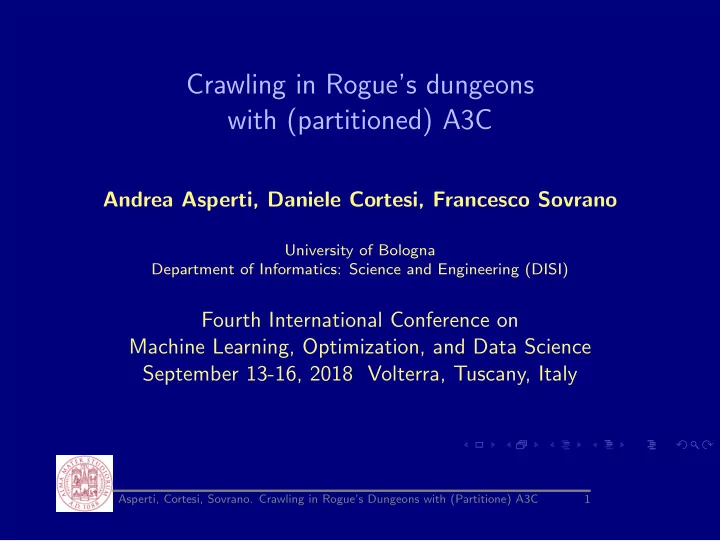

Crawling in Rogue’s dungeons with (partitioned) A3C Andrea Asperti, Daniele Cortesi, Francesco Sovrano University of Bologna Department of Informatics: Science and Engineering (DISI) Fourth International Conference on Machine Learning, Optimization, and Data Science September 13-16, 2018 Volterra, Tuscany, Italy Asperti, Cortesi, Sovrano. Crawling in Rogue’s Dungeons with (Partitione) A3C 1
Learning to play Rogue through Reinforcement Learning Rogue: a famous video games of the ’80, the ancestor of this gender. The player (the rogue) must retrieve the amulet of Yendor inside a dungeon composed of many levels, collecting objects and fighting enemies. We exclusively focus on roaming inside the dungeon: find the stairs and take them to descend to the next level. Asperti, Cortesi, Sovrano. Crawling in Rogue’s Dungeons with (Partitione) A3C 2
Why games Game-like environments, providing abstractions of real-life situations, have been at the core of many recent breakthroughs in Deep RL (mostly by Deep Mind): • Atari Games: DQN [4], A3C [3] (Mnih et al.) • Sokoban: Imagination augmentation [6] (Weber et al.) • Labyrinth: ACER [5] (Wang et al.) Mazes and labyrinths are a traditional topic of reinforcement learning, often requiring memory , attention , and the acquisition of complex, non-reactive behaviors based on long-term planning . Asperti, Cortesi, Sovrano. Crawling in Rogue’s Dungeons with (Partitione) A3C 3
Why Rogue Rogue has many challenging features for Deep RL: • no level replay : dungeons are randomly generated and always different from each other • partially observable (POMD): the map gets discovered during exploration • sparse rewards The ASCII interface allows us to focus on the really challenging aspects of the game, bypassing image detection problems (by now well understood). Asperti, Cortesi, Sovrano. Crawling in Rogue’s Dungeons with (Partitione) A3C 4
Rogueinbox In previous works [2, 1] we developed an API for Rogue, easing the development of automatic agents; the library was tested of many architectures, comprising Qlearning, A3C, and ACER. Rogueinabox allows an easy configuration of many game parameters, such as: ◮ monsters ◮ traps and secret passages ◮ dark rooms and mazes ◮ starvation a Rogue layer configured ◮ location of the amulet to just contain mazes Asperti, Cortesi, Sovrano. Crawling in Rogue’s Dungeons with (Partitione) A3C 5
Achievements overview Proviso: ◮ we just focus on movement : no monsters, objects, food, ... ◮ learning based on a single level : find and take the stairs - no dark rooms, no traps, no hidden passages - maximum steps: 500 moves Achievements: agent random DQN [2] this work succes rate 7% 23% 98% Table: Achievements overview Asperti, Cortesi, Sovrano. Crawling in Rogue’s Dungeons with (Partitione) A3C 6
Main architectural ingredients 1. the adoption of A3C as learning framework 2. an agent-centered, cropped representation of the state 3. a supervised partition of the problem in a predefined set of situations , each one delegated to a different A3C agent A3C (Mnih et al.) “On-policy” technique: - A syncronous: exploting a set of asynchronous agents - A dvantage: a formal notion expressing the convenience of an action in a given state - A ctor- C ritic: the policy π is the actor and the value function V is the critic. Asperti, Cortesi, Sovrano. Crawling in Rogue’s Dungeons with (Partitione) A3C 7
Neural network Asperti, Cortesi, Sovrano. Crawling in Rogue’s Dungeons with (Partitione) A3C 8
Situations and rewards Situations: Rewards: 1. +1 for entering a new door 1. corridor 2. stairs in view 2. +1 for discovering a new doors 3. +10 for descending the stairs 3. adjiacent to wall 4. other 4. − 0 . 01 for other actions Situations and rewards are quite ad-hoc (weak!!) Asperti, Cortesi, Sovrano. Crawling in Rogue’s Dungeons with (Partitione) A3C 9
Demo! Figure: Agent’s behaviour after 40 millions iterations A longer version is available on youtube Asperti, Cortesi, Sovrano. Crawling in Rogue’s Dungeons with (Partitione) A3C 10
Conclusions • The rogue movement is not perfect, but satisfactory • Some projectual choices are weak: - situations - rewarding mechanism - cropped view • We are already working on these issues with promising results Asperti, Cortesi, Sovrano. Crawling in Rogue’s Dungeons with (Partitione) A3C 11
Conclusions • The rogue movement is not perfect, but satisfactory • Some projectual choices are weak: - situations - rewarding mechanism - cropped view • We are already working on these issues with promising results thanks for your attention Asperti, Cortesi, Sovrano. Crawling in Rogue’s Dungeons with (Partitione) A3C 12
Bibliography A.Asperti, C.De Pieri, M.Maldini, G.Pedrini, and F.Sovrano. A modular deep-learning environment for rogue. WSEAS Transactions on Systems and Control , 12, 2017. A.Asperti, C. De Pieri, and G.Pedrini. Rogueinabox: an environment for roguelike learning. International Journal of Computers , 2:146–154, 2017. V.Mnih et al. Asynchronous methods for deep reinforcement learning. CoRR , abs/1602.01783, 2016. V.Mnih et al. Human-level control through deep reinforcement learning. Nature , 518(7540):529–533, 2015. Z.Wang et al. Sample efficient actor-critic with experience replay. 2016. T.Weber et al. Imagination-augmented agents for deep reinforcement learning. CoRR , abs/1707.06203, 2017. Asperti, Cortesi, Sovrano. Crawling in Rogue’s Dungeons with (Partitione) A3C 13
Recommend
More recommend